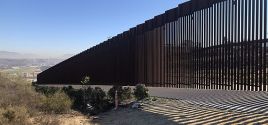Anthrax Vaccine Testing Called OffRenae MerleWashington Post Nov. 04, 2006 |
Popular 
Rep. Thomas Massie Warns Congress is Trying to Pass Hate Speech Laws to Outlaw Criticism of Israel

ADL Urged Congress to Pass FISA Law Spying on Americans to 'Protect Israel'

'Sniper Seen on Roof Overlooking Pro-Palestine Protest' at Indiana University

Claim Jewish Student Was 'Stabbed In The Eye' by Pro-Palestine Protester Draws Mockery After Video Released

Axios Poll: Majority of Americans Now Want Mass Deportations
 Federal drug regulators halted plans by a California biotechnology firm to begin human testing of an anthrax vaccine this month, throwing the fate of the troubled program into doubt. VaxGen Inc. officials said yesterday that it was unclear how long it would take to address Food and Drug Administration concerns about the vaccine's reliability. The delay prompted the Department of Health and Human Services to warn the company that it might terminate work potentially worth nearly $1 billion. The news sent The company's stock plummeting 56 percent, or $2.22, yesterday to close at $1.77 a share. The anthrax vaccine effort, already years behind schedule, is by far the largest component of the Bush administration's Project BioShield, a $5.6 billion effort to counter bioterrorism threats. The military has used an anthrax vaccine produced by Emergent BioSolutions Inc. of Gaithersburg for years, but the government sought to produce another version with VaxGen. The firm has run into several technical problems, including a failed test on humans. FDA officials declined to comment, but the company said the agency's questions centered on the vaccine's "stability," or the rate at which it would deteriorate while stockpiled. "We were encouraged by the improvements we've made to the vaccine and the stability data we have compiled, and we felt it supported reentry into the clinic," James P. Panek, VaxGen's executive vice president, said in a conference call with analysts. "Unfortunately the FDA disagreed, citing remaining concerns about the vaccine's stability." VaxGen officials said they hoped to hold a teleconference with the FDA next week and an in-person meeting within 30 days, but acknowledged that the FDA controls the timetable. "We're anxious to have that meeting to get a better sense of the FDA's concern and more importantly to try to find a path forward," Lance K. Gordon, president and chief executive, said during the conference call. Addressing the FDA's doubts could require VaxGen to generate new data on the current vaccine formula or make more improvements to it, Gordon said. VaxGen officials said that some deterioration in the potency of the vaccine is be to expected when it is stockpiled. "The fundamental scientific question that we need to address with FDA is whether the changes in the potency that we're observing . . . are significant and potentially clinically meaningful," Panek said. The Department of Health and Human Services sent VaxGen a "cure" notice yesterday, which is often a precursor to a contract termination. The FDA's action "is endangering performance of the contract," Brian K. Goodger, an HHS contracting officer, said in a letter to VaxGen yesterday. Unless the issue is addressed within 10 days, "the government may terminate for default," he wrote. HHS spokesman Bill Hall said no decisions have been made on the program's future. Panek declined to comment on the notice or the status of the contract, which called for VaxGen to begin human testing by Nov. 13. The delay also raises questions about VaxGen's ability to stay in business long enough to finish the project. Company officials said there was enough cash to fund operations through 2007. But VaxGen is not scheduled to begin delivering the vaccine until 2008 or 2009, which is when the company would receive most of the funding under the HHS contract. The company declined to comment on how much it has. VaxGen probably has about $50 million in cash but could generate about $50 million more by selling its interest in a joint venture that includes a manufacturing facility in South Korea, said Sharon R. Seiler, a senior biotechnology analyst for investment bank Punk Ziegel & Co. "I think they can accomplish this," said Seiler, who owns VaxGen shares and whose employers provided investment banking services to the company. "The question is what the timeline is going to look like and how much more resources it's going to require." VaxGen was picked for the project in 2004 despite having never successfully produced a drug. The contract calls for the company to produce enough of the vaccine for 25 million people, roughly the equivalent of the population in the New York and Washington metropolitan areas combined. |



